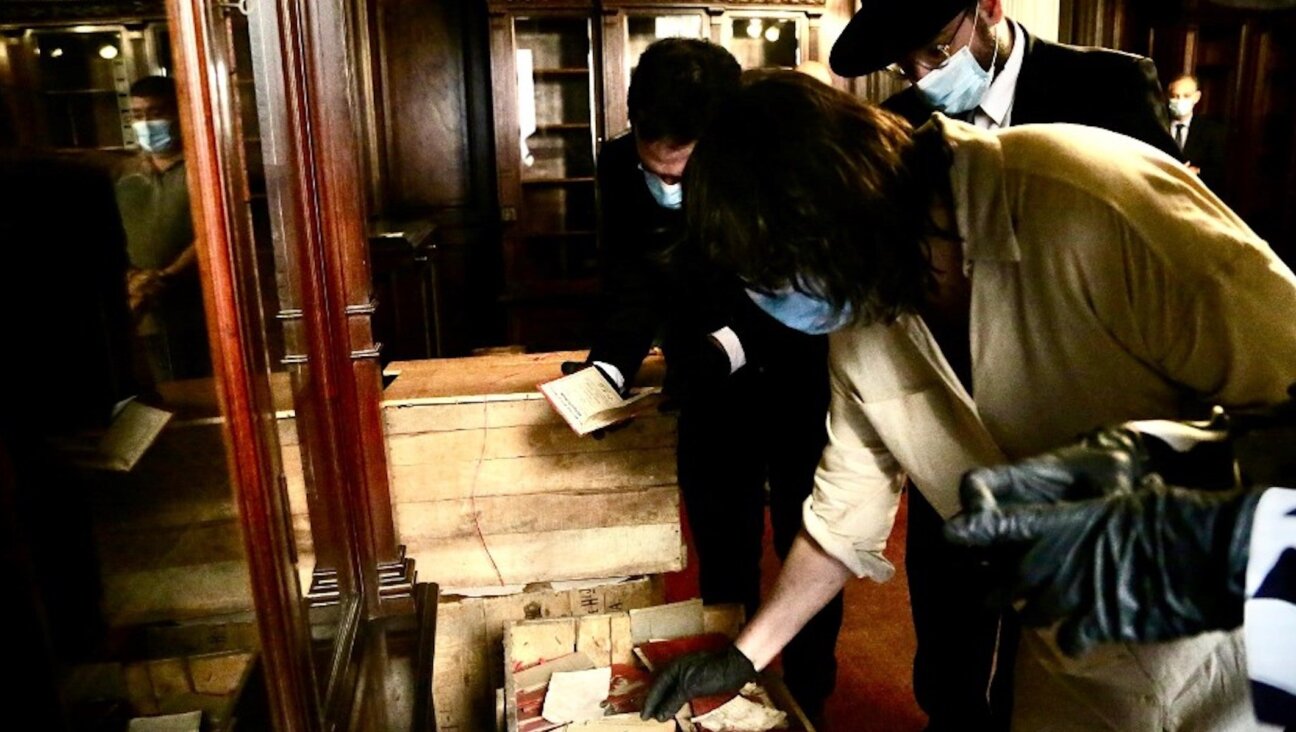Hasidic Rebels Find Home in Brooklyn Chabad Congregation

Rebels in Crown Heights: A unique community of Hasidic rebels is carving out a niche for itself in Brooklyn. Image by Avi Crevoshay
On a freezing Friday night in Brooklyn, a group of 18 Crown Heights residents scurry through the crowds of Jews leaving synagogue and make their way to a second-story apartment on Rogers Avenue for Shabbat dinner.
Inside, hippie art and vintage John Lennon photos share wall space with drawings of Rabbi Menachem Mendel Schneerson, the late leader of the Chabad hasidic sect, and a yellow “Moshiach” flag, the symbol of the movement’s messianic wing. A large glass table holds the evening’s spread: sauteed vegetables, kale salad, vegan cholent and a challah so perfect, attendees say, “only a gay man could have baked it.”
After a ceremonial blessing over wine and bread, the guests get to talking. A disc jockey, graphic artist and rabbi are having a heated discussion about Chabad’s influence on Indian meditation, while a photographer is explaining to a pregnant lady why Mitzvah Tanks, Chabad’s outreach vehicles, are the most brilliant thing to happen to planet Earth since Miles Davis.
This is not your typical Shabbat dinner in Crown Heights, the worldwide headquarters of the Chabad movement.
While nearly all the participants were raised in hasidic homes, most have strayed from strict religious practice. Yet rather than flee the neighborhood, they have chosen to remain in the heart of the Chabad community.
“The way I grew up, you had to either be 100 percent committed to religion or you’re out. There was no picking and choosing,” said Shmuley Toron, the 25-year-old gay man from Cincinnati responsible for the perfect challah. “But there are parts of the religion that I love, which is why we’re still here in Crown Heights. And I know I can be as religious as I want to be without having to leave completely.”
Toron and his friends are part of a community of Chabad misfits who, while not fully embraced by the Crown Heights mainstream, are beginning to find a place for themselves in an outwardly conformist community. His apartment has gained a reputation as the place people go to party, relax or escape the neighborhood’s rigid social norms – a situation that is virtually unthinkable in other hasidic communities, which are more likely to shun members that don’t fully abide by communal standards.
“The acceptance fringe members see in Crown Heights is really rare to that community, and it wouldn’t happen anywhere else,” said Hella Winston, a sociologist and author of the 2006 book “Unchosen: The Hidden Lives of Hasidic Rebels.” “Crown Heights is a type of place that is much more tolerant that most insular, hasidic communities. And their attitude is that they will mostly meet you where you are.”
One of 13 siblings raised in a Chabad family, Toron kept his sexuality a secret through years of religious camps and schooling, including a stint in a rabbinical seminary. He finally came out to his family four years ago, and still maintains some religious practices – keeping a full beard, covering his head and learning Tanya – though he doesn’t associate with communal institutions.
He does attend a new synagogue, however: Chevra Ahavas Yisroel, or CAY, led by Rabbi Chezzie Denebeim, a 27-year-old Californian, and his wife, Sima, who pride themselves on creating an environment open to everyone.
Compared to a typical Chabad synagogue, CAY is revolutionary. Board members are mostly women, who are permitted to lecture and sing along during services, and there is no dress code. Social events are coed, without a mechitzah gender partition.
The synagogue has been around for two years and recently purchased its own space, despite occasional opposition and criticism from the community.
“Our shul breaks the black and white in this community. It comes with color,” Denebeim said. “I can’t say that we have an agenda, I just want each person to embark on their own personal journey at our shul. And if they don’t and just come for the music, that’s fine, too.”
The community around CAY has become something of a magnet for the wayward children of Chabad families from across the country. Aviva Bogart, the 21-year-old daughter of a Chabad rabbi in Massachusetts with a partially shaven head, says more misfits have been moving to the area.
“This feels like the first time there’s in-reach within the community, instead of sending efforts to help those in the outside world,” Bogart said, referring to the global outreach corps of Chabad emissaries. “I think Chabad is beginning to realize how many people are getting lost and losing their religion, and how much of a change they really need. We’re not all completely lost, just because we don’t keep everything.”
When Toron first came out as gay, his mother cried incessantly and begged him to go to reparative therapy, fearful of the ostracized life he would live. Today, Toron has a boyfriend and says he is happier than ever.
“When I first realized I was gay, I wanted to toss the whole thing,” Toron said. “I felt like an abomination, I was so ashamed. And it’s terrifying, but I’m still trying to figure out where I stand, with my religion and my sexuality. I’m constantly living with one foot in and one foot out, but a part of me knows I can’t let go.”
Not surprisingly, not everyone in Crown Heights is embracing the new arrivals.
Last week, Bogart said a stranger approached her while she was walking to synagogue and demanded that she pull down her skirt. Bogart said there is an old-school mentality within the community, but she thinks it will change as CAY grows.
“Sure, I’m afraid to mix the pot and change things up, but there’s no other option,” Denebeim said. “Everyone here is status quo and that is a very dangerous thing.
“We needed something else because what we have is not working. You have to remember that the rebbe was revolutionary, too, and he taught us to be leaders, not followers.”
The Forward is free to read, but it isn’t free to produce

I hope you appreciated this article. Before you go, I’d like to ask you to please support the Forward.
Now more than ever, American Jews need independent news they can trust, with reporting driven by truth, not ideology. We serve you, not any ideological agenda.
At a time when other newsrooms are closing or cutting back, the Forward has removed its paywall and invested additional resources to report on the ground from Israel and around the U.S. on the impact of the war, rising antisemitism and polarized discourse.
This is a great time to support independent Jewish journalism you rely on. Make a gift today!
— Rachel Fishman Feddersen, Publisher and CEO
Support our mission to tell the Jewish story fully and fairly.
Most Popular
- 1

Fast Forward Ye debuts ‘Heil Hitler’ music video that includes a sample of a Hitler speech
- 2

Opinion It looks like Israel totally underestimated Trump
- 3

Culture Is Pope Leo Jewish? Ask his distant cousins — like me
- 4

Fast Forward Student suspended for ‘F— the Jews’ video defends himself on antisemitic podcast
In Case You Missed It
-

Fast Forward For the first time since Henry VIII created the role, a Jew will helm Hebrew studies at Cambridge
-

Fast Forward Argentine Supreme Court discovers over 80 boxes of forgotten Nazi documents
-

News In Edan Alexander’s hometown in New Jersey, months of fear and anguish give way to joy and relief
-

Fast Forward What’s next for suspended student who posted ‘F— the Jews’ video? An alt-right media tour
-
Shop the Forward Store
100% of profits support our journalism
Republish This Story
Please read before republishing
We’re happy to make this story available to republish for free, unless it originated with JTA, Haaretz or another publication (as indicated on the article) and as long as you follow our guidelines.
You must comply with the following:
- Credit the Forward
- Retain our pixel
- Preserve our canonical link in Google search
- Add a noindex tag in Google search
See our full guidelines for more information, and this guide for detail about canonical URLs.
To republish, copy the HTML by clicking on the yellow button to the right; it includes our tracking pixel, all paragraph styles and hyperlinks, the author byline and credit to the Forward. It does not include images; to avoid copyright violations, you must add them manually, following our guidelines. Please email us at [email protected], subject line “republish,” with any questions or to let us know what stories you’re picking up.














